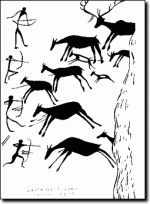Characters (pictures)
More and more people begin to take interest in Oriental culture, especially in Oriental alphabet. Character is a unique symbiosis of painting and writing, often possessing deep philosophic meaning.
Ideography is a writing system using symbols for defying objects and definitions instead of letters that correspond with letters. The peak of ideographic development became ideography writing system. Ideographic clues are some kind of graphical elements or simple characters of Chinese writing that is part of the complicated characters. They can serve as a meaningful or phonetic attribute, and are often called radicals.
Radicals were formed in ancient times from simplified pictograms (pictures).Radicals are divided into two types:
- Character that has meaning, reading and is used independently
- Character that has meaning, but lost reading and is not used independently today only as a part of character .
Often character has several meanings, each meaning expresses only one idea. Character is shaped from standard traits repeated in different combinations, and is not a whole sentence or word combination, with subject and predicate present simultaneously.
Characters might be formed in different ways. For instance, most ancient characters evolved through simplified pictograms, modern ones by combining radicals and existing characters. It’s worth to notice that the latter are often used as part of new characters due to similar phonetics, but not meaning.
Form of character or radical don’t say anything of their meaning. All the independently used characters have one or several meanings. However after leaning the meaning of all the radical it’s still hard to guess the character’s meaning. Finally it is sometimes possible to find a certain link between meaning of the character and that of its radical parts. It can change over the centuries as well as emerge along with new definitions or outdate that usual processes in every language.
Some characters present simplified pictures of this or that object, others for more complicated definitions derive from clue, more simple characters.
Examples:
- Character “man” is a picture of legs and body (they avoided picture of head for fear of magic). Hands were absent since it came to slave whose labor was possessed by his master
- Character “big, great” was shaped by adjusting “hands” to “man”
- Character “woman” is formed of hands, legs and body (head wasn’t depicted ). A bit deformed: with two traits-gratings, that can be translated as follows “penalty impose don woman for violating ethics”, is used as a sign of denial
- Character “mountain” depicts three peaks. It might be connected with nature of the places from which writing derives
- Character “water” is a stream. Vertical is bed with waves on the right and on the left
- Character “fire” is a bolt of firewood with points of spark on both sides
- Character “eye” stands vertically, two central traits mean pupil. If you add “legs” then it will mean “go and see”, if instead of legs you add “moustaches” it will be translated as “shell” (moustaches as eyes of mollusk living in a shell). Shells were employed in financial operations, so character “shell” contributed to the formation of sins linked with “money”.
These are few of many character peculiarities. Character as was said above is a unique combination of painting and writing, a picture with a certain meaning. People devote their lives to detail studying of characters in order to realize their nature.
返回目录




